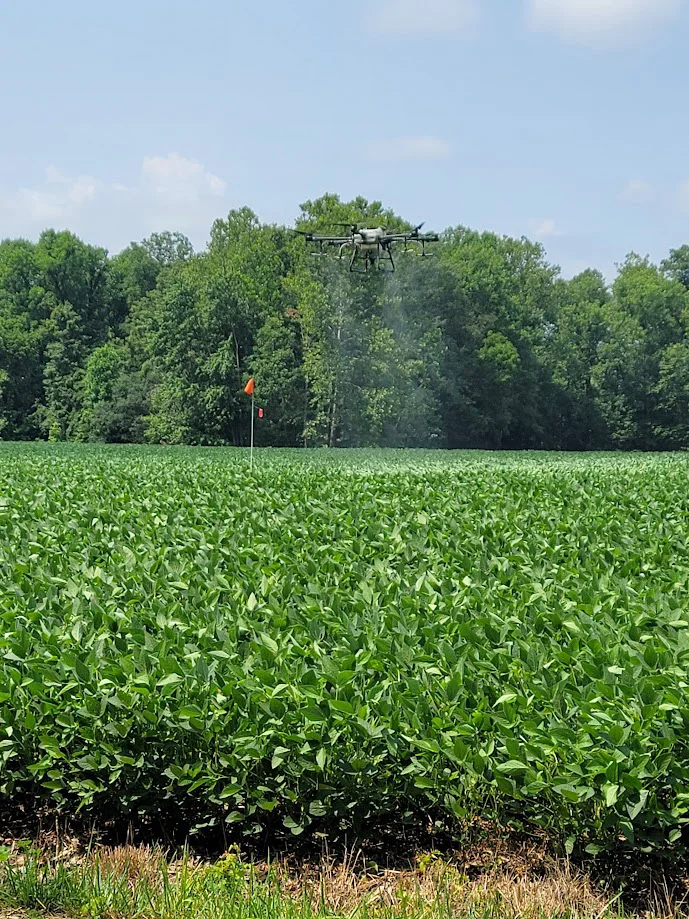This article was originally published via Soybean Research and Information Network Jul 8, 2024.
By Carol Brown
Drones are becoming valuable tools in the agriculture industry. These unmanned aerial vehicles, or UAVs, can do a number of tasks for farmers including field scouting, cover crop seeding, as well as fertilizer, herbicide and fungicide applications. But there are still some unknowns when using drone technology for these purposes.

A UAV applying fungicide on a soybean field at a Purdue University research plot. Researcher Darcy Telenko measures the spray deposition and how well the applied fungicide penetrated into the soybean canopy for the reduction of soybean foliar diseases. Photo: Darcy Telenko
Plant pathologist Darcy Telenko is determining the effectiveness of drone use for soybean disease management through a project funded by the Indiana Soybean Alliance. The associate professor with Purdue University Extension is conducting research on drone-applied fungicides to reduce soybean foliar diseases.
“I want to see if drones could achieve the fungicide coverage needed to manage or mitigate diseases including frogeye leaf spot, Septoria brown spot and Cercospora leaf blight,” Telenko explains. “We are comparing drone application rates to traditional on-the-ground fungicide applications for best efficacy.”
Telenko is applying fungicide at two rates, 2 and 5 gallons per acre, with the UAV to soybean research plots at three Purdue University research farms. She and her team compared these rates to fungicide applied at 20 gallons per acre with a ground rig. All were applied at R3 and R5 soybean stages. The project included a non-treated soybean control plot.
“One of the variables with crop research is that diseases don’t always appear where and when we want them,” she says. “We had little disease pressure in 2023, but we tried to answer questions including how deep were the drone-applied fungicides getting into the soybean canopy, how wide the spray actually reached, and how heavy was the spray dispersion.”Several limitations of UAVs may play a part in fungicide efficacy such as whether the drone is equipped with the right nozzles. Some drone nozzles cannot be switched out to achieve the most accurate spray width or droplet size.
Telenko also analyzed soybean yield, which was similar across all plots at each site. After one year of research, the drone applications performed as well as the ground rig for reduction of frogeye leaf spot at both R3 and R5 stages. The drones were better at controlling Septoria brown spot than the ground-rig in terms of diseased plant percentage, but the differences weren’t statistically significant. The 2- and 5-gallon per acre carrier volume amounts via the drone were similarly successful in controlling the disease. Spraying with a reduced carrier volume means that more acreage could be covered by the drone before refilling the tank. This will not reduce the fungicide per acre cost to the farmer, but it may offset the labor cost for the custom application.
Drone Benefits and Challenges
Drones have numerous advantages when it comes to agricultural work. Under wet field conditions, they can enter a field sooner than ground equipment. They can reach all areas of the field, even the tight-turnaround spots, and they can more easily avoid obstacles like a pole or a tree line.
There are caveats with using UAVs as well. Drone battery life is a consideration along with tank capacity, in addition to licensing and certifications for flying a UAV.
“One limitation of drone usage is battery life – we can only get so many passes across the field before the battery needs to be swapped,” comments Telenko. “Another consideration is having a place near the fields to charge batteries, refill tanks, and for fungicide mixing and wash-outs.”
There are different FAA rules based on the total weight of the drones, she says. Depending on the size of the drone, there are different requirements for registration, which limits the amount of fungicide it can carry across the field. Farmers also need to be cognizant of products and ensure they are labeled for aerial application.
Telenko is partnering with staff at the Purdue research farms who have drone piloting licenses and applicator certifications. Flying a UAV for fungicide or other chemical application requires a separate applicator permit, which varies by state. Purdue Extension has a useful checklist for flying drones in Indiana that can be a good resource for anyone interested in getting started.
Plant diseases appearing in a field are never good, but Telenko needs to have them in order to get useful results. If conditions are right, these diseases will reappear within the research plots for more data collection this coming season. In addition to the three soybean diseases she focused on in the previous trials, she is adding white mold to the project. The research was also conducted in corn plots for tar spot and gray leaf spot through other funding sources.
Additional Resources
2023 Applied Research in Field Crop Pathology for Indiana – Pp. 48, 50, 52
Meet the Principal Investigator on this project: Darcy Telenko
Published: Jul 8, 2024
The materials on SRIN were funded with checkoff dollars from United Soybean Board and the North Central Soybean Research Program. To find checkoff funded research related to this research highlight or to see other checkoff research projects, please visit the National Soybean Checkoff Research Database.



 and then
and then